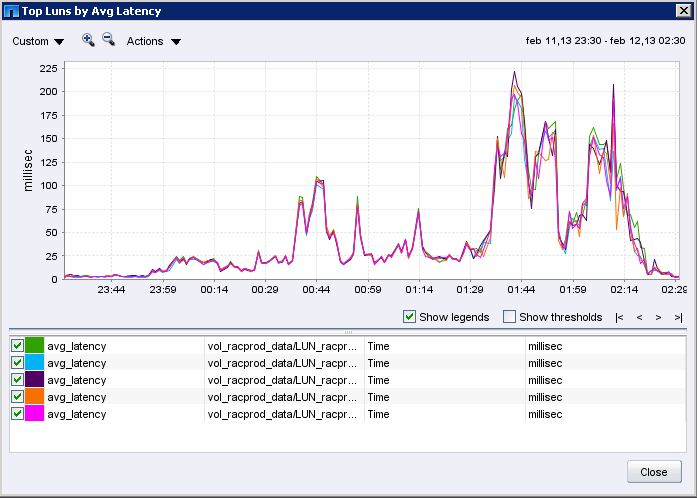ONTAP Discussions
- Home
- :
- ONTAP, AFF, and FAS
- :
- ONTAP Discussions
- :
- Oracle Database 11.2 slow performance on NetApp FAS3240
ONTAP Discussions
- Subscribe to RSS Feed
- Mark Topic as New
- Mark Topic as Read
- Float this Topic for Current User
- Bookmark
- Subscribe
- Mute
- Printer Friendly Page
Oracle Database 11.2 slow performance on NetApp FAS3240
- Mark as New
- Bookmark
- Subscribe
- Mute
- Subscribe to RSS Feed
- Permalink
- Report Inappropriate Content

Throughput
On "controller 2" on the same a aggregate we have created several volume for deploy a SQL Server 2012 Enterprise Edition used by our BI team
Latency
Throughput
My feeling is that the storage has a poor performance when Oracle execute multiblock IO operations, Oracle could execute bigger (in size) multiblock IO operations than SQL Server because of that the issue only happen with Oracle.
Please, Any one running Oracle with a similar environment has detected any similar issue or could give me any feedback about how can I solve this issue.
Thank you in advance, regards
- Mark as New
- Bookmark
- Subscribe
- Mute
- Subscribe to RSS Feed
- Permalink
- Report Inappropriate Content
Additionaly you can run a sis status -l and check for start time as well as duration of any dedupe operations.
- Mark as New
- Bookmark
- Subscribe
- Mute
- Subscribe to RSS Feed
- Permalink
- Report Inappropriate Content
Hi,
There is no deduplication operations enabled because for Oracle information located has no report any significative improvement.
Output of the command is:
STOMTSZRH020> sis status -l
No status entry found.
Regards
- Mark as New
- Bookmark
- Subscribe
- Mute
- Subscribe to RSS Feed
- Permalink
- Report Inappropriate Content
Hy Henry
Around midnight backup process are running, but database backup runs from 00:00-06:00 with a parallelism of 2. and the issue only happens when I export biggest tables and the throughput is more or less the same. We have a test case and we can reproduce this issue in any moment.
Take into account that this is a ideal environment, an aggregate connected to a single machine dedicated to run a single database, because of that we have isolate the issue.
Regards
- Mark as New
- Bookmark
- Subscribe
- Mute
- Subscribe to RSS Feed
- Permalink
- Report Inappropriate Content
You may wish to try Balance to ping point the bully process or escalate this case to the NA performance team for in deep analysis.
Good luck & Good w/e
Henry
- Mark as New
- Bookmark
- Subscribe
- Mute
- Subscribe to RSS Feed
- Permalink
- Report Inappropriate Content
Hey,
See if you can upload the AWR report for prior/post change, as well as a perfstat for pre/post....
Use the following:
https://upload.netapp.com/hq/Userfile
And, for the user name - use lgreg@netapp.com
As others pointed out - the environment was quite busy. And just adding 2 disks tot he environment may be an indication that your were on the edge, and that little bit helped. Would be curious to see the wait events in Oracle as well as the type of IO (ie random or sequential)But, lets see if you can upload the AWR and PErfstat..
Questions:
Is there a significant difference between the EMC and Netapp in terms of memory/cache?
Is there a difference in the SGA size when using the different storage?
Is there a difference in the nbr of luns? Are the hosts properly configured for the SNA/iSAN stack for the host OS?
Be careful in regards to what you read with Metalink note 1500460.1 - there are some unique OS versions that this is impacted upon. As well as it was in regards to an "upgrade" from one version of ONTAP to another. I sense that you are in a "new deployment" based on the thread.
But regardless - see if you can upload the AWR reports from the EMC and with where you are now at this point..Would also be good to see perfstat for the pre/post change with the additional disk too..
Regards,
- Mark as New
- Bookmark
- Subscribe
- Mute
- Subscribe to RSS Feed
- Permalink
- Report Inappropriate Content
Hi Igreg,
Sorry but this week I have other issues more critical that this one.
Next week I will upload the requested files.
About your questions:
Is there a significant difference between the EMC and Netapp in terms of memory/cache?
EMC AX4 has 1 Gbytes of cache, is a entry level storage.
Is there a difference in the SGA size when using the different storage?
No, SGA size has been the same
Is there a difference in the nbr of luns?
We have increased the LUN size from 50 Gbytes on EMC to 100 Gbytes on NetApp due our current size.
Are the hosts properly configured for the SNA/iSAN stack for the host OS?
I hope so , I have reviewed the netapp best practices about it an the system is setup as suggested
Be careful in regards to what you read with Metalink note 1500460.1 - there are some unique OS versions that this is impacted upon. As well as it was in regards to an "upgrade" from one version of ONTAP to another. I sense that you are in a "new deployment" based on the thread.
This note is the reason about we are working on a 8.0.2 instead a 8.1. This week Oracle has published an upgrade to solve it, I will deploy next weeks.
Regards
